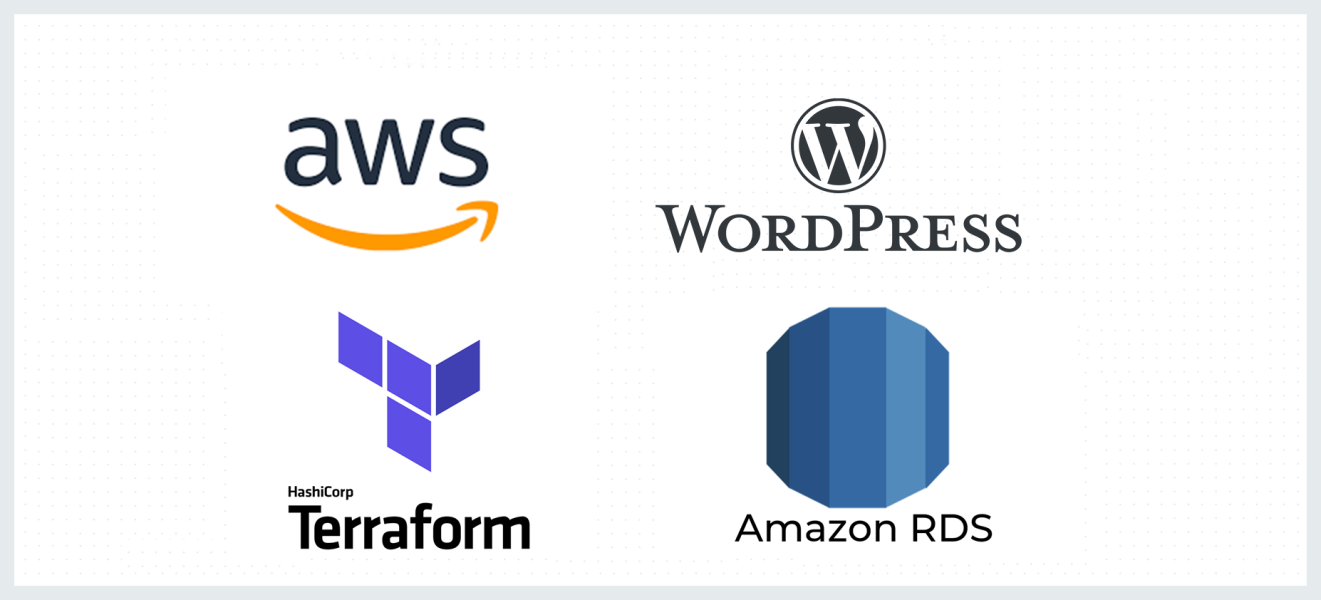O objetivo desse projeto é realizar o deploy do wordpress de forma automatizada
Confira o código completo aqui no github
Para isso estou usando as seguintes tecnologias
- AWS
- RDS
- EC2
- Terraform
- Ansible
- Docker
- Wordpress
- NGINX
Estrutura básica dos diretórios
╭─ ~/Code/deploy-wordpress juam-veras !16 ?5 ▓▒░······················░▒▓ ✔ 16:29:06 ─╮
╰─ tree -L 3
.
├── ansible # Contendo as roles, vars e playbooks pro deploy da arquitetura.
│ ├── bkp-hosts
│ ├── hosts
│ ├── main.yml
│ ├── roles
│ │ ├── common # Role pra pacotes basicos
│ │ ├── docker-cluster # Inicia o cluster do swarm
│ │ ├── docker-deploy # Faz o deploy dos docker-composes.
│ │ ├── docker-install # Instala o docker, pip requeriments e add user aos grupos
│ │ ├── wordpress # Instalação e configuração do wordpress-apache
│ │ └── wp-ports
│ └── vars
│ ├── main.yml
│ └── tf_ansible_vars_file.yml # Variaveis geradas pelo terraform
├── README.md
├── terraform # Arquivos do terraform pra deploy da ec2, rds, networks, security groups etc
│ ├── data.tf
│ ├── init.sh
│ ├── instances.tf
│ ├── locals.tf
│ ├── main.tf
│ ├── network.tf
│ ├── outputs.tf
│ ├── provider.tf
│ ├── rds.tf
│ ├── security-group.tf
│ ├── terraform.tfstate
│ ├── terraform.tfstate.backup
│ └── variables.tf # Arquivo pra definir as variaveis do terraform
├── terraform.tfstate
└── Vagrantfile
10 directories, 21 files
Terraform
Neste projeto o terraform está sendo naturalmente responsavel por gerar toda a parte de Rede como VPC, Subnet, Gateway, EC2, RDS, Security group como pode ser visto abaixo.
Já o processo de execução é o classico terraform init, plan e apply
╭─ ~/Code/wordpress-aws-deploy/terraform main !1 ?1 ▓▒░······················░▒▓ ✔ us-east-1 19:35:57 ─╮
╰─ terraform init ─╯
Initializing the backend...
Initializing provider plugins...
- Finding hashicorp/aws versions matching "~> 4.16"...
- Finding latest version of hashicorp/local...
.....
╭─ ~/Code/wordpress-aws-deploy/terraform main !1 ?1 ▓▒░······················░▒▓ ✔ 7s us-east-1 19:36:07 ─╮
╰─ terraform plan ─╯
data.aws_ami.ubuntu_ami: Reading...
data.aws_ami.ubuntu_ami: Read complete after 0s [id=ami-0c1704bac156af62c]
Terraform used the selected providers to generate the following execution plan. Resource actions are indicated with the following symbols:
+ create
Terraform will perform the following actions:
# aws_db_instance.mysql_db will be created
+ resource "aws_db_instance" "mysql_db" {
+ address = (known after apply)
+ allocated_storage = 10
+ apply_immediately = (known after apply)
+ arn = (known after apply)
+ auto_minor_version_upgrade = true
}
.......
Plan: 14 to add, 0 to change, 0 to destroy.
Changes to Outputs:
+ private_ip = (known after apply)
+ public_dns = (known after apply)
+ public_ip = (known after apply)
+ rds_endpoint = (known after apply)
─────────────────────────────────────────────────────────────────────────────────────────────────────────────────────────────────────────
Note: You didn't use the -out option to save this plan, so Terraform can't guarantee to take exactly these actions if you run "terraform apply" now.
.......
╭─ ~/Code/wordpress-aws-deploy/terraform main !1 ?1 ▓▒░······················░▒▓ ✔ 5s us-east-1 19:41:09 ─╮
╰─ terraform apply ─╯
data.aws_ami.ubuntu_ami: Reading...
data.aws_ami.ubuntu_ami: Read complete after 1s [id=ami-0c1704bac156af62c]
Terraform used the selected providers to generate the following execution plan. Resource actions are indicated with the following symbols:
+ create
Terraform will perform the following actions:
# aws_db_instance.mysql_db will be created
+ resource "aws_db_instance" "mysql_db" {
+ address = (known after apply)
+ allocated_storage = 10
+ apply_immediately = (known after apply)
.......
aws_db_instance.mysql_db: Still creating... [4m30s elapsed]
aws_db_instance.mysql_db: Creation complete after 4m39s [id=terraform-database]
local_file.tf_ansible_vars_file_new: Creating...
local_file.tf_ansible_vars_file_new: Creation complete after 0s [id=fab95d8ef388fdb452006e1da8f2fc295df0644c]
Apply complete! Resources: 14 added, 0 changed, 0 destroyed.
Outputs:
private_ip = "10.0.1.155"
public_dns = "ec2-54-227-217-109.compute-1.amazonaws.com"
public_ip = "54.227.217.109"
rds_endpoint = "terraform-database.c2vyhwdzispb.us-east-1.rds.amazonaws.com:3306"
A partir dai a parte de infraestrutura em si está pronta, o terraform gerará o arquivo hosts e tf_ansible_vars_file.yml os valores prontos para serem executados no ansible.
╭─ ~/Code/wordpress-aws-deploy/ansible main !1 ?1 ▓▒░······················░▒▓ ✔ us-east-1 19:48:21 ─╮
╰─ cat hosts ─╯
───────┬──────────────────────────────────────────────────────────────────────────────────────────────────────────────────────
│ File: hosts
│ Size: 398 B
───────┬──────────────────────────────────────────────────────────────────────────────────────────────────────────────────────
1 │ # Ansible hosts containing inventory values from Terraform.
2 │ # Generated by Terraform mgmt configuration.
3 │
4 │ [all:vars]
5 │ ansible_user='ubuntu'
6 │ ansible_become=yes
7 │ ansible_ssh_private_key_file=~/.ssh/madra.pem
11 │ ansible_python_interpreter=/usr/bin/python3
12 │
13 │ [aws]
14 │ 54.227.217.109
15 │
───────┬──────────────────────────────────────────────────────────────────────────────────────────────────────────────────────
╭─ ~/Code/wordpress-aws-deploy/ansible main !1 ?1 ▓▒░······················░▒▓ ✔ us-east-1 19:48:24 ─╮
╰─ cat vars/tf_ansible_vars_file.yml ─╯
───────┬──────────────────────────────────────────────────────────────────────────────────────────────────────────────────────
│ File: vars/tf_ansible_vars_file.yml
│ Size: 330 B
───────┬──────────────────────────────────────────────────────────────────────────────────────────────────────────────────────
1 │ # Ansible vars_file containing variable values from Terraform.
2 │ # Generated by Terraform mgmt configuration.
3 │
4 │ WORDPRESS_DB_HOST: terraform-database.c2vyhwdzispb.us-east-1.rds.amazonaws.com:3306
5 │ WORDPRESS_DB_USER: wordpress
6 │ WORDPRESS_DB_PASSWORD: supersenha123
7 │ WORDPRESS_DB_NAME: wordpress
8 │
9 │ mgmt_net: 10.0.1.0/24
10 │
11 │ user: ubuntu
12 │
Para executar o ansible o comando é o seguinte:
╭─ ~/Code/wordpress-aws-deploy/ansible main !1 ?1 ▓▒░···································································································································░▒▓ ✔ us-east-1 19:51:23 ─╮
╰─ cd ansible && ansible-playbook -i hosts main.yml -vvv ─╯
ansible-playbook [core 2.13.4]
config file = /home/juamsv/.ansible.cfg
configured module search path = ['/home/juamsv/.ansible/plugins/modules', '/usr/share/ansible/plugins/modules']
ansible python module location = /usr/lib/python3.10/site-packages/ansible
ansible collection location = /home/juamsv/.ansible/collections:/usr/share/ansible/collections
executable location = /usr/bin/ansible-playbook
python version = 3.10.7 (main, Sep 6 2022, 21:22:27) [GCC 12.2.0]
jinja version = 3.1.2
.....
Agora é só esperar alguns minutos e acessar pelo endpoint fornecido no output do terraform :D.
Proximos ajustes:
- Validar se existe ssh key, caso não, gerar uma.
- Corrigir o redirecionamento do NGINX
- Adicionar o variables.tfvars.exemple
- Rodar o ansible automaticamente com o ansible_local pelo terraform
- arrumar algumas coisas do ansible ex: flush dos handlers ao final de algumas roles.
